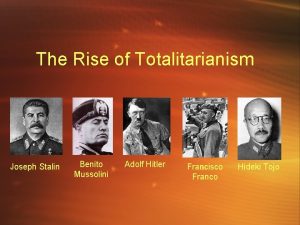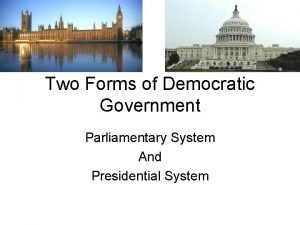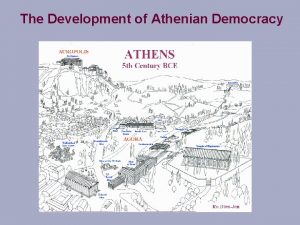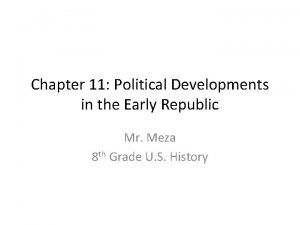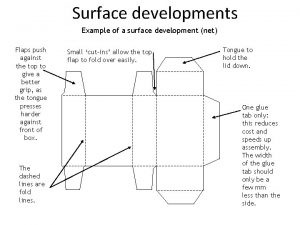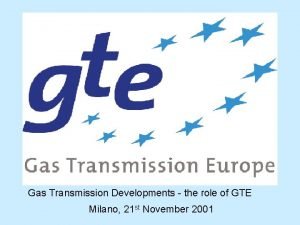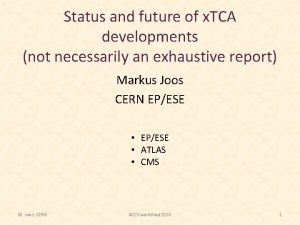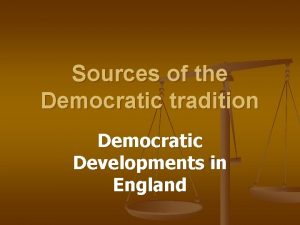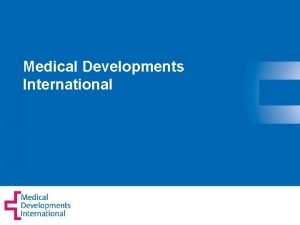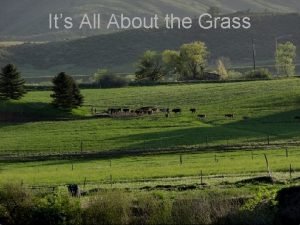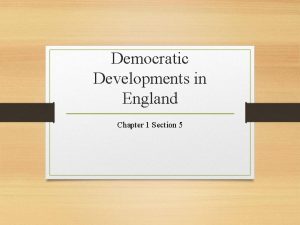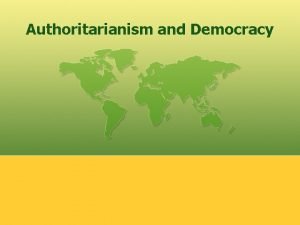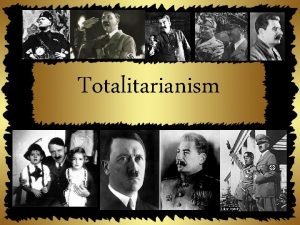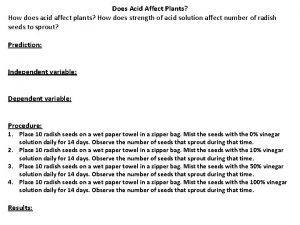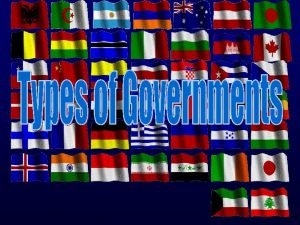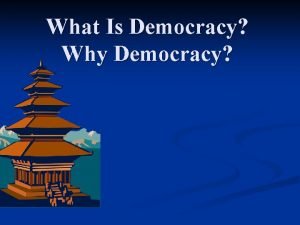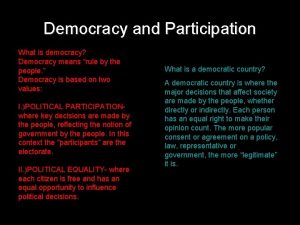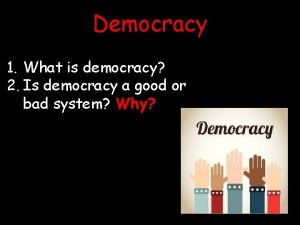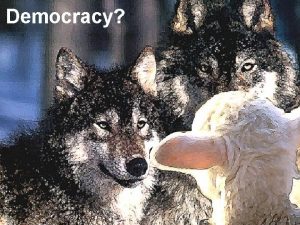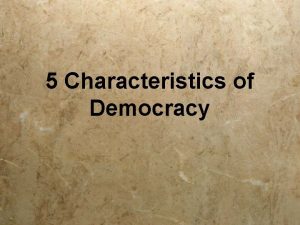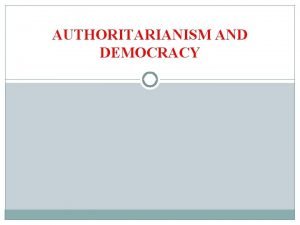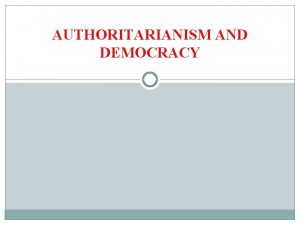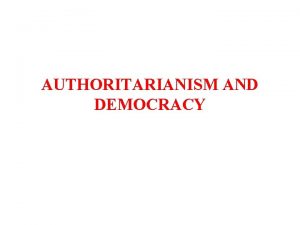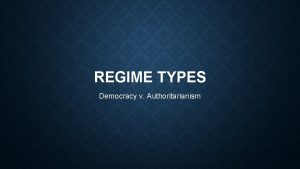Authoritarianism Democracy Developments HOW DOES AUTHORITARIANISM AFFECT DEVELOPMENT























- Slides: 23

Authoritarianism, Democracy & Developments HOW DOES AUTHORITARIANISM AFFECT DEVELOPMENT? ROSS MCGREGOR, SARAH IJEAL, JONATHAN ROSSI & ZOE THOMAS-LUCHTE

Outline �We will be examining the correlation between development and democracy and authoritarianism �First we’ll define each term �We have two case studies; Turkey and Saudi Arabia �In both states we’ve compared societal, political and economic development

Authoritarianism �‘Limited pluralism and the lack of extensive and intensive mobilization of the population’ (Munck, G. 2010. p 27) �A limited amount of influence on the political process and decision making from internal groups. The elite are almost completely autonomous. �The general population has little to no influence over any political process

Democracy �‘Gasiorowski’s definition of democracy includes three main components: competition for political offices, highly inclusive level of political participation and a ‘’sufficient level’’ of civil and political liberties to ‘’ensure the integrity of political competition’’ (Pevehouse, J. 2005. p 67) �Open elections, everyone has the right to vote & rights and liberties

Development �Within the following case studies we will be examining political, social & economic development. �Economic development can be measure in access to infrastructure, GDP, etc. �Social development can be measures by HDI, life expectancy, education, etc. �Political development can be measured by political inclusion and extent of freedom of political oppositions etc.

Politics �Three sets of actors in the political sphere in the Middle East: 1. Ruling establishments 2. Secular parties 3. Islamist Movements

Saudi Arabia �State officially founded in 1933 but began in the 18 th century. �The state is rule by the Al-Saud family. �The family expanded its power through an alliance with Muhammad ibn Abd al-Wahhab. �Oil was discovered in the 1930 s. �The ruling Al-Saud family holds a monopoly of power. �Holds a significant role in the Middle East. �It is an absolute monarchy.

Turkey �Previously known as Asia minor or the Anatolian Peninsula. �The Republic of Turkey was created in 1923 and Kemal Ataturk was named its President. �Became secular in 1928. �The first open elections were held in 1950. �In 2002 the current Islamist based ruling party, the ‘Justice and Development Party’ or AKP (Adalet ve Kalkınma Partisi) won the election.

Social Effects • • • Population Literacy Level Urbanization Rate Life Expectancy Poverty Levels Education • Source: UN database http: //hdr. undp. org/en

HDI (Human Development Index) �Turkey � 1980 = 0. 496 2013 = 0. 759 Ranked 69 th worldwide �Saudi Arabia � 1980 = 0. 583 2013 = 0. 836 Ranked 34 th worldwide

GNI (Gross National Income) per capita �Turkey � 2005 = $6, 520 2013 = $10, 950 �Saudi Arabia � 2005 = $12, 460 2013 = $26, 200

Population and Literacy Rate �Turkey 1980 = 43. 90 million 94. 1% (15 and above) 2013 = 74. 93 million �Saudi Arabia 1980 = 9. 84 million 2013 = 28. 82 million 87. 2% (15 and above)

Urban Population and Life expectancy �Turkey � 1980 = 43. 8 million � 1980 = 58. 7 years 2013 = 73. 4 million 2013 = 75. 3 years �Saudi Arabia � 1980 = 65. 9 million � 1980 = 63. 0 years 2013 = 82. 7 million 2013 = 75. 5 years

Education and Health Expenditure (% of GDP) �Turkey �Education �Health 1980 = 1. 7 1980 = 4. 9 2013 = 2. 9 2013 = 6. 7 1980 = 5. 9 1980 = 4. 3 2013 = 5. 6 2013 = 3. 7 �Saudi Arabia �Education �Health

Economic Development In Turkey and Saudi Arabia How has Authoritarianism affected the Saudi Arabian Economy? � huge contingency in their inner workings and economic characteristics. � The main difference between the two economies can be argued as the nature of their main income. With Saudi Arabia receiving 70% of all revenue from petrochemicals and refineries, as a ‘rentier’ state, and Turkey expanding their trade boundaries and variety of produce. � Saudi Arabias GDP sits at 743 bn USD, and Turkey at 820 bn USD. These figures, although abstract somewhat suggest that authoritarianism is not detrimental to economic development with SA’s increasing by four times since 1990.

Economic Development in Turkey • In 1923 turkey was declared a republic after the fall of the Ottoman Empire. At this stage, the economy was under developed and relied mainly on agriculture for revenue. • In 1928, Turkey became secular and aimed to adopt a method of economic policy based on western economic values. • In 1961 a two-chamber parliament was established after the 1960 military coup against Menderes. • Economic development was slow due to another coup in 1971, and the change of prime minister 11 times before 1980. The currency was devalued in 1960 and inflation was at almost 80% in the late 60’s.

Economic Development In Turkey � During the 1980’s & 90’s Turkey received revenue for oil pipelines from Iraq due to its location. However with the start of the gulf war, became disused until 1996, causing decline in annual revenue. � Turkey underwent a decline in the state sector whilst still recognising its role, encouragement of foreign investment and showed high inflation and low economic growth in comparison to neighbouring states (with rentier oil-driven economies).

Economic Development In Turkey � In 1997 the IMF began an 18 month monitoring program in hopes to reduce inflation, this was extended in 2001 and economic growth inclined until brief recession in 2009 due to the global economic crisis, followed by recovery. � Turkeys economy now exports mainly to Europe, Iraq, Russia, USA, UAE and Iran, and GDP is represented mainly by manufactured goods, raw minerals, transport equipment, machinery and agriculture, which make up half the annual revenue.

Economic Development In Saudi Arabia � Saudi Arabia (formerly the province of Hasa) was obtained by the Ottoman Empire in the late 1800’s. � Similar to Turkey, Saudi Arabia had an agriculture based economy until the discovery of oil in the 1930 s and the establishment of the kingdom of Saudi Arabia by Abd-al-Aziz. In 1938 oil production began in Saudi Arabia and is US controlled (Arabian American Oil Company). � Economic development did not start inclining quickly until the 1970 s, when SA government obtained part of Aramco and therefore received 20% of oil revenue.

Economic Development In Saudi Arabia � Saudi Arabia was involved in the oil boycott of western states during the Arab Israeli war. � This led to high oil prices, meaning high economic growth. � However, this led to the increase of oil wells globally therefore decreasing the amount of oil obtained internationally from Saudi Arabia. Oil production decreased from 10 million barrels per day to 2 million. In 1980 -1 SA gained full control of Aramco. � Throughout the 1990 s Saudi Arabia saw the expansion of Aramco and obtaining the state refining company. This became the world’s first fully integrated oil production company � The 1990 s consisted of huge neoliberal reforms including the expansion of the private sector and reduction in government subsidies.

Economic Development In Saudi Arabia � Water and electricity prices were raised in order to promote efficiency. Further privatisation aims included post services, air ports, telecommunication and education. These plans have been suspended however due to government debt to nationalised corporations. E. g. petrochemical companies. � Saudi Arabia has implemented policy to encourage the employment of Saudi nationals due to the high percentage of foreign workers. � This is due to the wage disparity between nationals and foreigners, and the way employers benefit from employing foreign workers. � In recent years, Saudi Arabia (SAGIA- Saudi Arabia General Investment Authority) has also opened up markets such as water, electricity and gas to foreign investors. Customs have been lowered from 12%-5% since 2001 in order to promote free trade. � The average wage in Saudi Arabia is 16, 262 SAR, however the minimum wage is 800 SAR. With one SAR being equivalent to 0. 27 USD.

Comparison and Analysis � We can see that although Saudi Arabia has a similar GDP and overall income to Turkey, the nature of growth has not been from expansion of the market variety, but from the expansion of the market of oil. � Although this resources are in high demand, and producing revenue, the structure of the authoritarian regime does not allow necessary wealth circulation necessary to benefit the entire state and its population economically. � This can be seen in the enormous amount of foreign workers in Saudi Arabia and the huge wage disparity between nationals and immigrants. � We can see this also in the generally low minimum wage and privatisation of human commodities. � Although economic growth is maintained and reaped by the government of Saudi Arabia due to the 70% ownership of dominant industry, the rentier nature of the economy suggests possible future hindrance of this branch of authoritarianism on the economic development of Saudi Arabia

Bibliography �Pevehouse J C. , 2005, Democracy from Above: Regional Organizations and Democratization, Cambridge University Press �Munck, G. L. , 2010, Authoritarianism and Democratization: Soldiers and Workers in Argentina, 1976 -1983, Penn State Press
 Authoritarianism vs totalitarianism
Authoritarianism vs totalitarianism Definition of presidential form of government
Definition of presidential form of government The development of athenian democracy
The development of athenian democracy Recent developments in ict
Recent developments in ict Recent developments in object detection
Recent developments in object detection Cultural development of sahelanthropus tchadensis brainly
Cultural development of sahelanthropus tchadensis brainly Chartered developments
Chartered developments Political developments in the early republic
Political developments in the early republic Huron creek
Huron creek Chapter 11 political developments in the early republic
Chapter 11 political developments in the early republic Surface developments
Surface developments Transmission developments
Transmission developments In the colonial era developments such as the new england
In the colonial era developments such as the new england Target developments
Target developments Patterns of development
Patterns of development What are the two types of pattern development
What are the two types of pattern development Comtel atca
Comtel atca Democratic developments in england
Democratic developments in england Cplim
Cplim Name
Name Mdi vision
Mdi vision Donmeg developments
Donmeg developments How did parliament emerged victorious in medieval england
How did parliament emerged victorious in medieval england The goose-step cartoon analysis
The goose-step cartoon analysis
